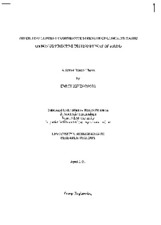| dc.contributor.advisor | Burt, Richard | |
| dc.contributor.advisor | Woods, Paul | |
| dc.creator | Coots, Emmit Kevin | |
| dc.date.accessioned | 2013-02-22T20:40:30Z | |
| dc.date.available | 2013-02-22T20:40:30Z | |
| dc.date.issued | 2001 | |
| dc.identifier.uri | https://hdl.handle.net/1969.1/ETD-TAMU-2001-Fellows-Thesis-C665 | |
| dc.description | Digitized from print original stored in HDR. Due to the character of the original source materials and the nature of batch digitization, quality control issues may be present in this document. Please report any quality issues you encounter to digital@library.tamu.edu, referencing the URI of the item. | en |
| dc.description | Includes bibliographical references (leaf 27). | en |
| dc.description | Program year: 2000/2001 | en |
| dc.description.abstract | There are many ways to test the compressive strength of concrete to include both destructive and non-destructive methods. There are many pros and cons associated with the various methods of testing to include cost, size, and method associated with each piece of equipment. The most common types of testing are the hydraulic compression test, the rebound test, and the maturity test. An alternative method proposed that would give individuals another means to test concrete in a non-destructive manner. The purpose of this research is to determine the current compressive strength of concrete by analyzing the acoustic pattern of a sound made by a hammer striking the surface of a concrete cylinder in a lab environment. Concrete cylinders were made in the traditional fashion and the sound generated when a ball-ping hammer strikes the cylinder was recorded then analyzed. The cylinders were tested on a daily basis and their compressive stress was recorded. Linear regression was used to try and predict the compressive strength of the concrete cylinders. The regression model chosen using the stepwise selection method could only account for 43% of the variation in the compressive strength. The duration of the sound wave was the best predictor of the compressive strength. | en |
| dc.format.extent | 34 pages | en |
| dc.format.medium | electronic | en |
| dc.format.mimetype | application/pdf | |
| dc.language.iso | en_US | |
| dc.rights | This thesis was part of a retrospective digitization project authorized by the Texas A&M University Libraries in 2008. Copyright remains vested with the author(s). It is the user's responsibility to secure permission from the copyright holder(s) for re-use of the work beyond the provision of Fair Use. | en |
| dc.subject | concrete | en |
| dc.subject | compressive strength | en |
| dc.subject | hammer | en |
| dc.subject | acoustic pattern | en |
| dc.title | Predicting current compressive strength of concrete based on non-destructive testing by way of sound | en |
| dc.type | Thesis | en |
| thesis.degree.department | Construction Science | en |
| thesis.degree.grantor | University Undergraduate Research Fellow | en |
| thesis.degree.name | Fellows Thesis | en |
| thesis.degree.level | Undergraduate | en |
| dc.type.material | text | en |
| dc.format.digitalOrigin | reformatted digital | en |


